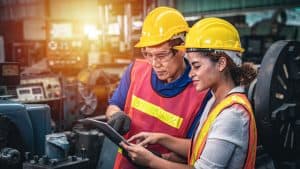
Edge computing and 5G unleash the potential to improve the lives of factory workers, solve growing labor shortages, and contribute to a more sustainable planet.
She drove 30 miles to a single-engine aircraft factory five days a week for 20 years. There she stood for 8 hours in a metal building on a concrete floor at her wooden inspection station. Anti-fatigue mats and high-tech “standing” shoes were not yet invented, and air conditioning was not in the razor-slim budget. In the early winter mornings, her breath lingered, cloudy in the frigid air. By high noon in the summer, the temperatures approached 115 degrees Fahrenheit. Dehydration, migraines, and repetitive stress injuries were her frequent companions.
Download Infographic Now: Manufacturing Leaders’ Viewson Edge Computing and 5G
On her first day, she was issued a set of welding gauges and a small paper handbook. A couple of hours of training later, she was on her own. She inspected the gaps between welded panels at her workbench and inside the narrow confines of fuselages. She rejected those that didn’t conform. The welders sometimes took those rejections personally.
She went up in a plane with the test pilot, just once, to show that she believed in her work and that the rejections were necessary to prevent catastrophe during operations and not personal. Jobs like hers were scarce back then, and she was grateful to have it. That was two generations ago; since then, working conditions have steadily improved in many factories.
Still, manufacturers face difficulties filling openings, and one-fourth of the manufacturing workforce in the U.S. is over age 55. Many factory workers are aging out, while others are leaving for jobs in areas such as professional services, trade, construction, and administrative and support services, according to the U.S. Census Bureau.
See also: The Many Use Cases in an Emerging ‘Industrial Metaverse’
Putting data to work for workers
As is the case in many industries, manufacturers are turning to data to help them attract and retain skilled workers with better working conditions and the potential to grow professionally. Two key technologies in the enterprise toolkit making these outcomes possible are edge computing and 5G. These technologies enable manufacturers to gather, analyze and instantly act on information flowing in from devices, sensors, assembly lines, and other data sources in their factories and their supply chains.
Many repetitive tasks, such as visual quality inspections in welding gaps, food products, packaging, and the like, can be automated. Even the welding itself can be improved using self-adjusting high-precision robot arms that learn from feedback based on quality data fed into artificial intelligence/machine learning applications. “Co-bots,” such as autonomous mobile robots, carry parts and assemblies to where they are needed, saving workers time, improving process flows, and reducing physical labor and the risk of injury. Training takes workers into virtual spaces where they can observe and practice new tasks in a safe environment without concern about impacting production operations. Workers can be reminded automatically to don protective gear as they enter higher-risk environments. Materials handling and supply chains can be better managed to achieve cost savings and sustainability.
How manufacturing leaders view edge computing and 5G
I am encouraged by the growing number of manufacturing sites recognized by the World Economic Forum’s Global Lighthouse Network initiative and the new sustainability designation these factories can achieve. These factories are leading the way in collaborating, learning, and adopting transformational technologies, such as edge computing and artificial intelligence, that enable the “Fourth Industrial Revolution.”
Dell Technologies-sponsored research with 350 manufacturing leaders reveals that a vast majority of respondents agree that edge computing and 5G connectivity are essential to manufacturing transformation. The findings also highlight the need for IT and operational technology (OT) teams to work more closely to achieve modernization–the cornerstone of this ongoing “revolution.”

A new era for a new kind of work
The hero of my personal story, my factory worker mom, is nearing the age of 92. When I ask, she reminisces that she actually enjoyed “getting out of the house.” That job, her sacrifice, sent me to college, a rare thing among my cohort. While I was there, a friend offered me a ride in a single-engine plane made at my mom’s factory. I took it.
Today, Mom is (or pretends to be) fascinated by the stories I tell her about how her work is accomplished in factories that rely on data and automation to do hard physical and monotonous work. If she were working today, she might be learning how to build parts from 3D printers, maintaining or helping deploy and train co-bots, or developing artificial reality or virtual reality courses to teach others how to do new tasks.
Factories that are safer for workers and give us more hope for sustaining our planet—these are the factories of the Fourth Industrial Revolution. They are our legacy to our children.
Learn more about what manufacturing leaders think about the challenges, impact, and adoption of edge computing and 5G in this video, infographic, and eBook.







